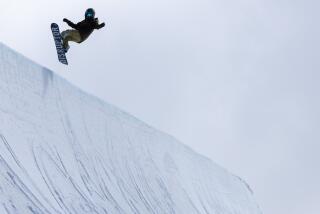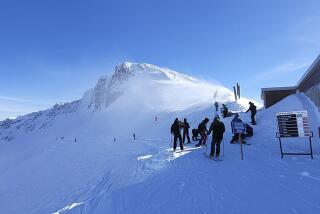Group Offers Rewards to Counter Skiers’ Deadly ‘Road Rage’
- Share via
ASPEN, Colo. — They say it’s the sound that hits them first, a loud and sharp crunching. A warning, like a knife sawing through ice, then the concussive smack, signaling contact with a flying body. It’s the sound of collisions on the ski slopes, and, thus far this season, they seem to be more numerous and more dangerous.
Barely three months into the ski season, seven people have died on Colorado’s slopes, five in collisions. There were four deaths last season. At New England resorts, the nation’s second most popular ski destination, there have been eight ski deaths; four in a recent three-day period.
Many here say that the “road rage” so familiar to motorists has been transplanted to ski runs. Call it “ski rage.” At Keystone resort, for example, charges of disorderly conduct and harassment have been brought against a snowboarder who took a jump in a restricted area and knocked over a skier. An off-duty ski patrol member saw the collision and confronted the snowboarder, who then punched the good Samaritan.
Researchers say annual skiing and snowboarding fatalities nationwide have remained generally steady, about 33 per year, far less than many other popular sports. But serious injuries are on the rise. According to the National Ski Areas Assn., serious injuries have increased in recent years, fluctuating from 12 in the 1984-85 season, to 27 in 1990-91, to 42 last season.
Statistics provided by the skiing industry, on the other hand, claim a slight decline in injuries, but they only count accidents that require emergency medical attention. A recent John Hopkins study concluded that ski injuries may be underreported by as much as 50%, but noted that unreported injuries are likely to be minor.
This, with fewer people on the slopes: Colorado’s skier visits were down 11% during the holiday season, which got off to a slow, snowless start. Nationally, the popularity of skiing is down slightly, even as snowboarding is on the rise.
Anger on the Slopes
There are several theories about what is fueling the anger on the slopes.
Some say that new, beginner-friendly equipment, such as shaped skis, makes novice skiers believe they are more skilled than they are. High-speed lifts whisk skiers back to the top of mountains almost before they’ve had a chance to catch their breath. The bulk of accidents happen when skiers are tired. Some say sophisticated equipment and grooming of steeper runs are fostering higher speeds.
The deterioration of traditional alpine etiquette has also been blamed, as has the lack of civility in society.
Whatever the causes, resorts are fighting back. At Aspen, a horrific hit-and-run accident has led to the creation of a nonprofit group, Ski Hit & Run Reward Inc., whose mission is to help identify and report to authorities skiers or snowboarders who cause collisions.
Even with a $1,000 bounty for turning in reckless skiers, the program--in its second year--has yet to catch a culprit. But organizers say they believe it is a deterrent. And other ski areas are looking at the group as a model to manage out-of-control skiing and excessive speed. Also in Colorado, Vail Resorts last week announced it was starting special safety patrols to crack down on reckless skiers.
The problem is not limited to the United States. Some French resorts--including Albertville, host of the 1992 Winter Olympics--have implemented sentences of up to a year in jail and fines reaching 100,000 francs ($17,000) to people causing serious accidents. Lesser tickets may be issued for “traffic offenses.”
What’s happening to the upscale sport once embodied by a sophisticated jet-setter wearing designer clothes for whom speed was a matter of getting to the lodge in time for apres ski festivities?
“Testosterone poisoning” is the assessment of Jasper E. Shealy, of the Rochester Institute of Technology in New York. Shealy has studied ski accidents for more than 26 years and says they are the inevitable outcome of young, risk-taking males traveling at excessive speeds. It is men, he says, who are involved with 90% of ski accidents.
A typical hit-and-run involved just such a young man and Ann Watson, 72. Watson and her husband, Jim, were skiing near their home at Snowmass Village in Colorado on a Sunday morning in December 1997.
“I heard this clod come roaring behind me,” she said. “I could hear he was out of control.” The skier hit her from the side, knocking her to the ground and breaking her right leg in 14 places. “I was screaming my head off. He hit me so hard I could have been killed. And he kept saying, ‘You’re OK, sweetheart.’ ”
Jim Watson clambered back to the scene and yelled at the young man for his reckless skiing. The reply was, “She got in my way.”
The man continued down the mountain, saying he would alert the ski patrol, but he never did. Ann Watson, a lifelong skier, required three surgeries to repair her leg. She may never ski again.
The incident outraged Jim Watson, who posted a reward to find the skier who caused the accident. That futile effort led to the formation of Ski Hit & Run Reward. The group runs a weekly ad in the two local newspapers offering rewards for information leading to the conviction of anyone who causes an accident and leaves the scene, which is against state law.
“If someone skis out of control, they’re breaking the law, besides being a jerk,” said Dick Durrance, co-founder of Ski Hit & Run Reward. “People need to follow the rules of the road on the hill as well as the highway.”
Tuck Busters
Although ski areas aren’t yet putting radar detectors on the slopes, Aspen Mountain has devised a visual method to track speeders: the Tuck Buster Program.
According to mountain manager Rob Baxter, “People who are in a tuck [position] are generally the M.O. of the type people we are looking for. Depending on their attitude and their past, for aggressive people we will take their lift tickets if they ski recklessly. Reckless skiing is defined by us as skiing inappropriately for the conditions, skiing too fast, skiing in and out of a crowded slope, not skiing in control and skiing beyond your ability.”
Most resorts have some sort of speed-control program, where ski patrol members are positioned along runs. Signs warn skiers not to wander out of bounds or into trees.
Last month the U.S. Consumer Product Safety Commission recommended that skiers and snowboarders wear helmets to reduce serious head injuries and deaths.
But one safety expert said helmets would cost consumers $50 million and would not prevent most skier-tree collision deaths. Others say helmets give a false sense of security and may actually encourage reckless behavior.
Snowboarders have been fingered by some as the culprits for the unruly behavior, fueled by their image as slackers of the slopes.
“I’m not prepared to condemn snowboarders as a group,” said Henry Schneider, 72, of Rye, N.Y, who was skiing at Aspen Mountain. “But they tend to be younger, which means more macho and less attuned to consequences. I’m beginning to find the presence of so many snowboarders quite unnerving. When you have hard-pack snow or ice, and the snowboard cutting over this hard pack, it makes a God-awful terrifying sound. When you hear this sound behind you, it’s enough to make you start looking over your shoulder.
“I ski with a 75-year-old friend. On two successive winters he was sent to the hospital by snowboarders, one of whom left him alone and unconscious in the snow.”
Radar studies indicate that the average speeds on intermediate slopes are 25 to 40 mph.
“The biggest thing I would recommend is that people don’t ski in trees,” said Shealy. That’s not a popular thing to say. If people would refrain from skiing in trees and at the margins of the trail, that would reduce 60% of all fatalities. . . . How you do that, I have no idea.”



